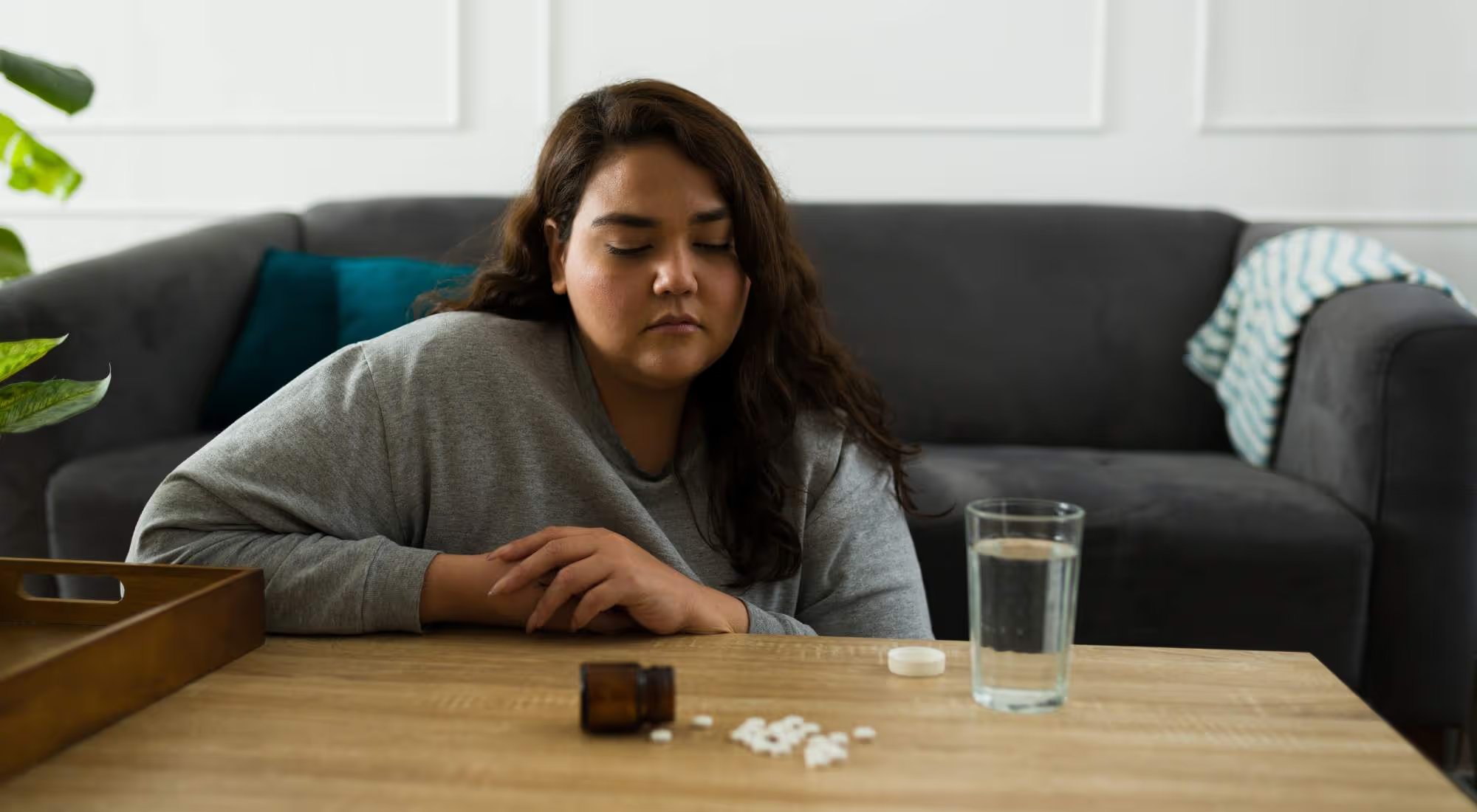Could Your Anxiety Be Linked to Drug and Alcohol Use? Understanding Substance-Induced Anxiety Disorder

You wake up drenched in sweat — heart pounding, and mind racing.
This scenario is all too common for people living with anxiety, but when the symptoms are powered by drugs or alcohol, the struggle is even more complicated.
Substance-induced anxiety disorder sits at the intersection of mental health and addiction, which can make diagnosis — and sometimes, treatment — challenging.
In this article, we’ll explore common symptoms of substance-induced anxiety disorder, risk factors, and how Dove Recovery can help.
Table of Contents
- Can Substance Abuse Lead to Anxiety?
- What Is Substance-Induced Anxiety Disorder?
- Criteria for Diagnosing Substance/Medication-Induced Anxiety Disorder
- What Kinds of Things Are Associated with Substance-Induced Anxiety Disorder?
- Common Symptoms of Substance-Induced Anxiety Disorder
- 4 Risk Factors That Increase the Chances of Substance-Induced Anxiety Disorder
- Take the First Steps Toward Healing Your Body and Mind at Dove Recovery
Substance abuse and anxiety can be directly interconnected and create a ruthless cycle.
Not only can using substances create symptoms of anxiety, but it may also intensify preexisting general anxiety. Substances change the brain’s chemistry, causing its ability to regulate your mood to be disrupted.
Substance-induced anxiety disorder (SIAD) occurs when substance abuse increases feelings of anxiety.
Several aspects of substance use may intensify feelings of generalized anxiety due to:
- Intoxication: Drinking alcohol leads to a cascade of effects, such as neurotransmitter imbalances, changes in blood sugar, dehydration, and elevated heart rate, which all contribute to anxiety.
- Withdrawal: Abruptly stopping use of drugs or alcohol leads to a drop in dopamine levels, which in turn may induce anxiety and depression.
- Brain toxicity: Substance use may result in damage to areas of the brain that regulate fear and emotions. It can cause the brain to detect even minor stimuli as a threat, increasing anxiety.
Substance-induced anxiety disorder is a mental health condition that occurs due to substance intoxication or substance withdrawal. A person who experiences this anxiety disorder exhibits nervousness, restlessness, and panic that can be tied directly to the use or abuse of:
- Alcohol
- Drugs
- Prescription medications
- Exposure to toxins

Not all anxiety disorders are substance-induced; however, when a person uses substances and has symptoms of an anxiety disorder, there are specific benchmarks that must be met for it to be classified as SIAD.
The criteria include:
- The substance being used is capable of producing the current symptoms.
- The symptoms didn’t already exist before initial use of the substance.
- The symptoms don’t continue after at least a month of not using the substance.
- The symptoms occur outside of moments of delirium.
- The symptoms cause an inability to function socially, at work, or in basic life skills.
- Clearly identifiable panic attacks or anxiety occur at the onset, or soon after, substance intoxication or withdrawal.
Substance-induced anxiety disorder can be associated with the use, abuse, and withdrawal of many substances, both illegal and legal. It is most common with alcohol, stimulants, and certain medications. Individuals with SIAD experience anxiety that is tied to the substance they are using, and the symptoms typically stop when they quit using the substance.
Tobacco and nicotine have their own category of disorders and are not associated with SIAD.
Legal Substances
Legal substances that may lead to SIAD include:
- Alcohol
- Caffeine
- Misuse or withdrawal of medicines used to treat anxiety
- Cannabis/THC
- Legally prescribed medications such as stimulants for ADHD, corticosteroids, and some asthma and thyroid medications
It is important to note that the risk of developing SIAD from using the substances above depends on dosage, individual health factors, and use with other medications. Each person’s level of risk will vary.
Illegal Substances
Illegal substances alter the brain’s chemistry, altering neurotransmitters and creating interruptions in the communication of brain cells. In turn, anxiety and depression can manifest.
Some illegal substances that may lead to SIAD include:
- Cocaine
- LSD
- Ketamine
- Cannabis/THC
- Ecstasy
- Amphetamines
- Synthetic stimulants
- Methamphetamines
Many of the symptoms exhibited by individuals with SIAD are akin to other generalized anxiety disorders, but the significant difference is that they are a direct result of substance use, abuse, or withdrawal.
Physical Symptoms
Using substances and the anxiety that results may present itself in one or more physical reactions, including:
- Fast heart rate
- Sweating
- Shakiness
- Difficulty breathing
- Chest pain
- Dizziness
- Fatigue
- Cold sweats or hot flashes
- Muscle tightness
Psychological Symptoms
SIAD also produces psychological symptoms that are disproportionate to the situation at hand, including:
- Irritability
- Overwhelming worry
- Trouble concentrating
- Nervousness
- Fear of losing control
- Fear of dying
- Fear of going crazy
If you are having difficulty functioning due to overwhelming anxiety and substance use, Dove Recovery can help. Our experienced and compassionate staff offer steadfast support for your recovery. Contact us today.
.jpg)
#1: Genetics
A combination of genetic and environmental factors can influence a person’s brain chemistry and the way the body responds to stress, and psychological factors may make a person more prone to developing SIAD.
Genetic factors can affect different parts of the brain, including the dopamine system and the amygdala. These systems control the body’s reactions to stress, rewards, and anxiety, as well as the processing of fear and anxiety. Genetic differences can affect the way a person’s brain and body react to drugs and alcohol.
Anxiety disorders are also affected by genetics, and the symptoms can be amplified when substances are introduced into the body.
#2: Pre-Existing Conditions
Having a history of certain pre-existing conditions may put some people at a higher risk of developing substance-induced anxiety disorders.
These conditions include:
- PTSD
- Other anxiety disorders
- Mood disorders
- Major depression
- Other substance use disorders
- Some medical conditions, such as hyperthyroidism
The symptoms of these disorders may both contribute to or be worsened by substance use, and in turn, they can lead to substance-induced anxiety disorder.
#3: Stress and Environmental Factors
People who experience chronic stress or high-stress environments are put at increased risk of both substance use and anxiety; therefore, the likelihood of developing substance-induced anxiety disorder is higher.
Another environmental factor is trauma. People who experience emotional or physical abuse are at high risk for both mental health conditions and substance abuse disorders, which can be significant risk factors for SIAD.
Adverse childhood experiences can also be a risk factor for anxiety and the likelihood of substance use. Toxic stress during childhood impairs brain development and changes the way the body reacts to stress, making it difficult to regulate emotions, which can lead to coping mechanisms such as substance use.

#4: Polydrug Use
Anxiety, panic attacks, and paranoia are common when combining substances. Using multiple substances stresses the central nervous system due to the opposing or unpredictable effects of different drugs.
The brain’s chemical balance is affected on a greater scale than if only one substance were present.
Mixing stimulants and depressants is particularly dangerous because it stresses the heart and other organs, creating heightened anxiety as the body tries to find a balance.
In other cases, some people may use substances to reduce withdrawal symptoms of other substances, creating more stress and anxiety in the body.
Are you ready to take control of your anxiety and put substance use behind you? At Dove Recovery, our comprehensive treatment programs focus on both the physical and mental aspects of recovery.
With customizable options to fit your individual needs, we offer:
- Counseling
- Therapy
- Detox
- Outpatient programs
- Partial hospitalization programs
We will work with you to determine which programs and evidence-based recovery options are suitable for your situation.
Our personalized care and support system is top-rated and can help you on every step of your recovery journey. Reach out today!
.jpg)
